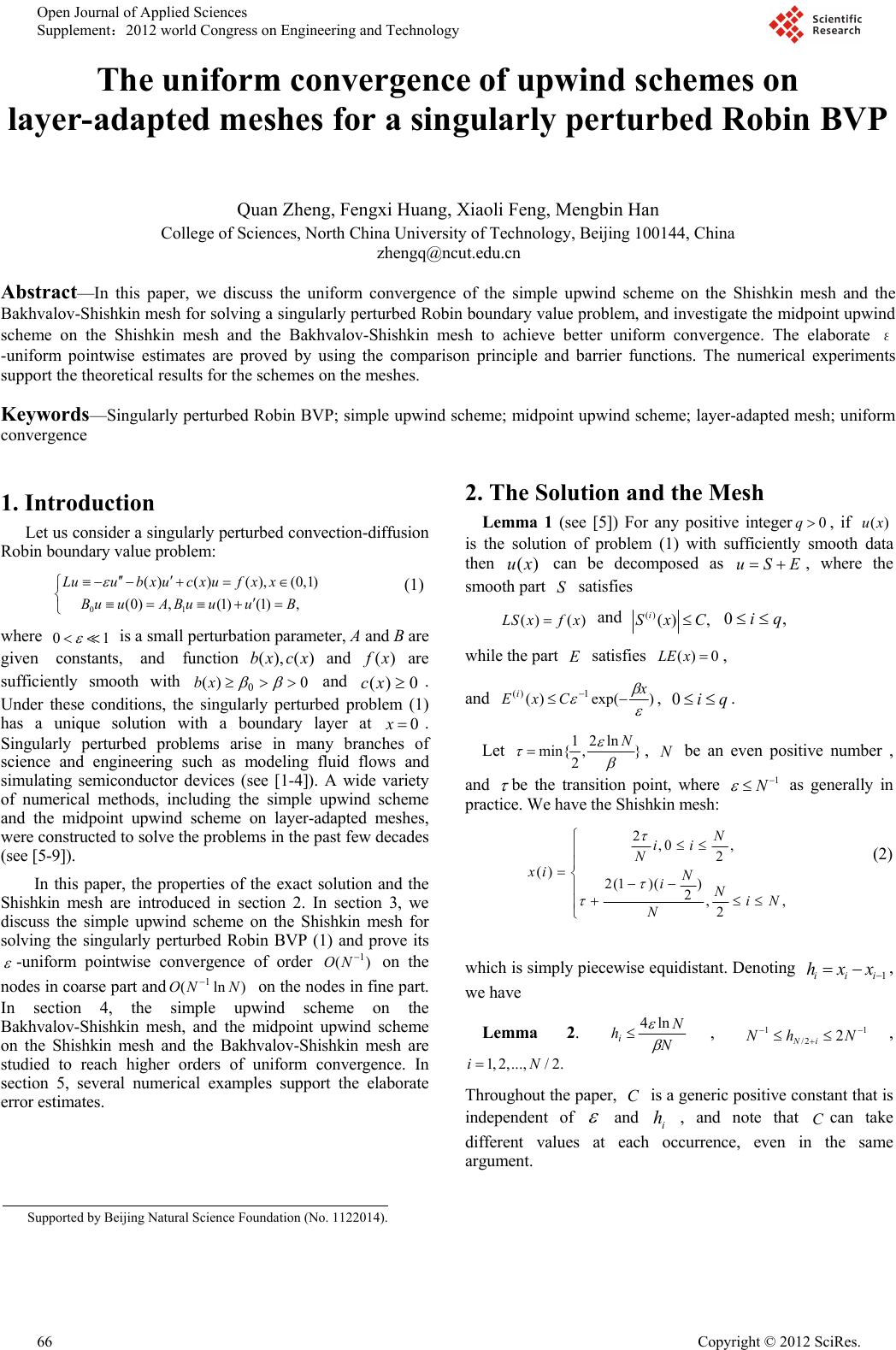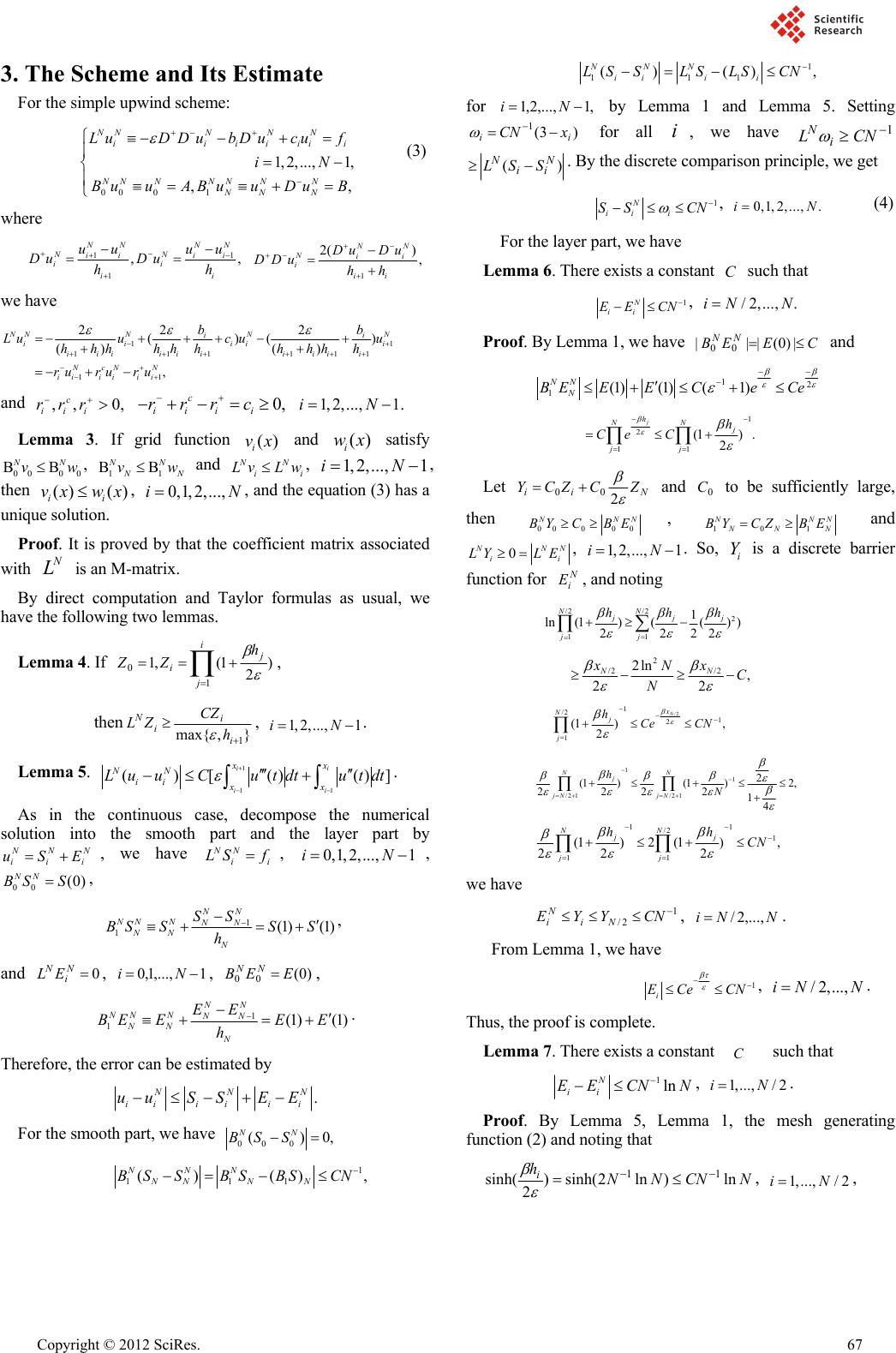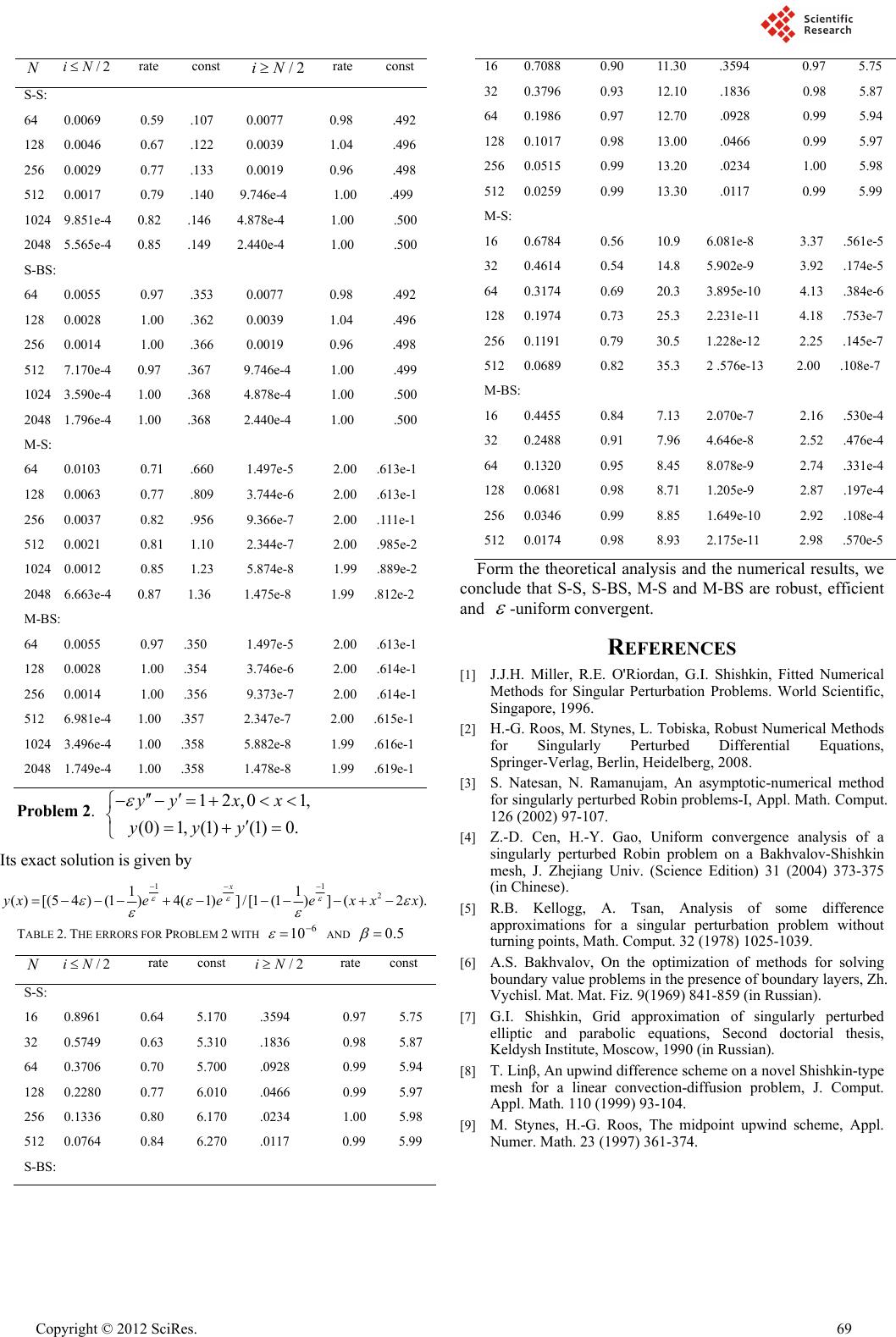Paper Menu >>
Journal Menu >>
 Supported by Beijing Natural Science Foundation (No. 1122014). The uniform convergence of upwind schemes on layer-adapted meshes for a singularly perturbed Robin BVP Quan Zheng, Fengxi Huang, Xiaoli Feng, Mengbin Han College of Sciences, North China University of Technology, Beijing 100144, China zhengq@ncut.edu.cn Abstract—In this paper, we discuss the uniform convergence of the simple upwind scheme on the Shishkin mesh and the Bakhvalov-Shishkin mesh for solving a singularly perturbed Robin boundary value problem, and investigate the midpoint upwind scheme on the Shishkin mesh and the Bakhvalov-Shishkin mesh to achieve better uniform convergence. The elaborate ε -uniform pointwise estimates are proved by using the comparison principle and barrier functions. The numerical experiments support the theoretical results for the schemes on the meshes. Keywords—Singularly perturbed Robin BVP; simple upwind scheme; midpoint upwind scheme; layer-adapted mesh; uniform convergence 1. Introduction Let us consider a singularly perturbed convection-diffusion Robin boundary value problem: 01 ()()(), (0,1) (0) ,(1) (1) , Lu ubxucxufxx Buu ABuuuB (1) where 01 is a small perturbation parameter, A and B are given constants, and function)(),( xcxband )(xf are sufficiently smooth with 0)(0 xb and 0)( xc . Under these conditions, the singularly perturbed problem (1) has a unique solution with a boundary layer at 0x . Singularly perturbed problems arise in many branches of science and engineering such as modeling fluid flows and simulating semiconductor devices (see [1-4]). A wide variety of numerical methods, including the simple upwind scheme and the midpoint upwind scheme on layer-adapted meshes, were constructed to solve the problems in the past few decades (see [5-9]). In this paper, the properties of the exact solution and the Shishkin mesh are introduced in section 2. In section 3, we discuss the simple upwind scheme on the Shishkin mesh for solving the singularly perturbed Robin BVP (1) and prove its -uniform pointwise convergence of order )( 1 NO on the nodes in coarse part and)ln( 1NNO on the nodes in fine part. In section 4, the simple upwind scheme on the Bakhvalov-Shishkin mesh, and the midpoint upwind scheme on the Shishkin mesh and the Bakhvalov-Shishkin mesh are studied to reach higher orders of uniform convergence. In section 5, several numerical examples support the elaborate error estimates. 2. The Solution and the Mesh Lemma 1 (see [5]) For any positive integer0q, if )(xu is the solution of problem (1) with sufficiently smooth data then ()ux can be decomposed as uSE , where the smooth part S satisfies () () L Sxf x and () () , i Sx C 0,iq while the part E satisfies 0)(xLE , and )exp()( 1)( x CxEi, 0iq . Let } ln2 , 2 1 min{ N , N be an even positive number , and be the transition point, where 1 N as generally in practice. We have the Shishkin mesh: 2,0 , 2 () 2(1)() 2,, 2 N ii N xi N iNiN N (2) which is simply piecewise equidistant. Denoting 1iii hxx , we have Lemma 2. N N hi ln4 , 11 /2 2 Ni Nh N , 1, 2,...,/2.iN Throughout the paper, C is a generic positive constant that is independent of and i h , and note that Ccan take different values at each occurrence, even in the same argument. Open Journal of Applied Sciences Supplement:2012 world Congress on Engineering and Technology 66 Copyright © 2012 SciRes.  3. The Scheme and Its Estimate For the simple upwind scheme: 00 01 1, 2,...,1, ,, NNNN N iiiiiii NN NNNNN NN N L uDDubDucuf iN Bu uABu uDuB (3) where 11 1 ,, NN NN NN ii ii ii ii uu uu Du Du hh 1 2() , NN Nii i ii Du Du DDuhh we have 1 1 111111 11 22 2 ()( ) () () , N NN NN ii ii iii iiiiiiiii i NcN N iiii ii bb L uu cuu hhhhhhhhh h rururu and ,, 0, c iii rrr 0, c iii i rrrc 1,2,...,1.iN Lemma 3. If grid function () i vx and () i wx satisfy 000 0 BB NN vw, 11 BB NN N N vw and NN ii Lv Lw, 1, 2,...,1iN , then ()() ii vx wx, 0,1, 2,...,iN, and the equation (3) has a unique solution. Proof. It is proved by that the coefficient matrix associated with N L is an M-matrix. By direct computation and Taylor formulas as usual, we have the following two lemmas. Lemma 4. If i j j i h ZZ 1 0) 2 1(,1 , then },max{ 1 i i i N h CZ ZL , 1, 2,...,1iN . Lemma 5. 1 11 ()[ ()()] ii ii xx NN ii xx L uu Cutdtutdt . As in the continuous case, decompose the numerical solution into the smooth part and the layer part by N NN iii uSE , we have NN ii L Sf , 0,1, 2,...,1iN , 00 (0) NN BS S, 1 1(1) (1) NN NNNNN NN N SS BS SSS h , and 0 N i NEL , 1,...,1,0 Ni, )0( 00EEB NN, 1 1(1) (1) NN NNN NN NN N EE BE EEE h . Therefore, the error can be estimated by . NN N iiiiii uu SSEE For the smooth part, we have 00 0 ()0, NN BS S 1 111 ()() , NNN NNN N BS SBSBSCN 1 111 ()(), NNN iii i L SSLS LSCN for ,1,...,2,1 Ni by Lemma 1 and Lemma 5. Setting )3( 1 ii xCN for all i, we have 1 CNL i N )( N ii NSSL . By the discrete comparison principle, we get 1N iii SS CN , 0,1, 2,...,.iN (4) For the layer part, we have Lemma 6. There exists a constant C such that 1N ii EE CN , /2,...,.iNN Proof. By Lemma 1, we have CEEBNN |)0(||| 00 and 12 1(1)(1) (1) NN N BE EECe Ce 1 2 11 (1) . 2 j h NN j jj h Ce C Let NiiZCZCY 2 00 and 0 C to be sufficiently large, then 0000 0 N NN BY CBE , 101 N NN N NN BY CZBE and 0 NNN ii LY LE , 1, 2,...,1iN . So, i Y is a discrete barrier function for N i E, and noting /2 /2 2 1 1 1 ln(1)(()) 2222 NN jjj j j hhh 2 /2 /2 2ln , 22 NN xx NC N /2 1 /2 1 2 1 (1 ), 2 N x Nj j hCe CN 1 1 /2 1/2 1 2 (1 )(1)2, 2222 14 NN j jN jN h N 11 /2 1 11 (1 )2(1 ), 22 2 NN jj jj hh CN we have 1 2/ CNYYE Ni N i, NNi,...,2/. From Lemma 1, we have 1 i E Ce CN , / 2,...,iN N. Thus, the proof is complete. Lemma 7. There exists a constant C such that 1ln N ii E ECNN , 1,...,/ 2iN. Proof. By Lemma 5, Lemma 1, the mesh generating function (2) and noting that NCNNN hiln)ln2sinh() 2 sinh( 11 , 1,...,/ 2iN, Copyright © 2012 SciRes. 67  we have 1 11 ()[ ()()] ii ii xx NN ii xx LEECEx dxEx dx 1 1 21 exp( )exp()sinh(), 222 i i xii x x h x CdxC 1 11 11 11 lnexp()ln(1) . 22 ii jj jj hh CN NCN N Let 1 0ln (1) ii CNN Z , from Lemma 4 and 6, we have 11 0ln( ) NNN iiii LCNNZLEE , 000 0 N EE , 1 /2 0/2/2 N NNN CN EE , provided that the constant 0 C is chosen sufficiently large. So, 1ln N ii i EECN N by a discrete comparison principle. Theorem 1. The simple upwind scheme on the Shishkin mesh for the singularly perturbed Robin boundary value problem (1) satisfies: 1 1 ln, 0, 2 ,. 2 N ii N CN N i uu N CNiN (5) Proof. It is proved by (4), Lemma 6 and 7. I. FURTHER RESULTS On the Bakhvalov-Shishkin mesh (see [8]): (), iii i xxttN ,0,1, 2,...,iN, where the mesh generating function is as follows: 211 ln(12(1)), 0, 2 () 2ln2ln11 2(1)(),1, 22 tt N xt NN tt (6) the simple upwind scheme for solving the singularly perturbed Robin BVP was proved to be uniform first-order convergence (see [4]): 1N ii uu CN ,0iN. (7) Further, we consider the midpoint upwind scheme for Dirichlet BVP in [9] to be modified for the Robin BVP (1) as follows: 1 111 222 11 222 00 01 , 1,2,...,1, 2 2 ()()(), 22 ,, NN NNNNii iii ii i NNN NN NN NNNNNN NN NNN NN NNNNN NN N uu LuDDub DucfiN bb Luucuuf hh hhh Bu uABu uDuB (8) where 11 ()/(2) NNN NNN N D uuu h . For 1, 2,...,1iN , we have 1/ 21/ 21/ 21/ 2 1 1 111 111 11 22 2 ()( ) ()2 ()2 , N NN NN ii ii ii ii iiiiiiiii i NcNN iiii ii bc bc Lu uuu hhhhhhhhh h rururu Supposed that chi/2 0 , we have ,, 0, c iii rrr 0 2/1 ii c ii crrr , 1, 2,...,1iN . For iN , from (8), we have 1 22 222 2 ()(). NN NN NNNNNNN NNN N Luucb ufbB hhh h The coefficient matrix associated with this N L is also an M-matrix and a discrete comparison principle holds. By using barrier functions, we can obtain the same error estimate on the Shishkin mesh for Robin BVP as that for Dirichlet BVP in the following: 1 2 ln, 0, 2 ,. 2 N ii N CN N i uu N CNi N (9) Moreover, we can prove that the midpoint upwind scheme on the Bakhvalov-Shishkin mesh has the uniform convergence: 1 2 ,0 , 2 ,. 2 N ii N CN i uu N CNi N (10) 4. Numerical Examples The numerical results in tables 1 and 2 agree with the error estimates for the simple upwind scheme on the Shishkin mesh and the Bakhvalov-Shishkin mesh, denoted by S-S and S-BS, and the midpoint upwind scheme on the Shishkin mesh and the Bakhvalov-Shishkin mesh, denoted by M-S and M-BS. The numerical convergence rates are computed by )max/(maxlog 2 2 N ii N ii uuuu on the coarse part and the fine part, respectively. Denoting the error estimate by )(|| NCuu N ii , the constant is computed by max/ ( ) N ii uu N . Problem 1. 0, 01, (0)0, (1)(1)1. yyy x yyy The exact solution of this problem is 1212 12 () ()/[(1)(1)] mxm xmm yxeem eme, where 12 ,(1(14))/(2)mm . TABLE 1. THE ERRORS FOR PROBLEM 1 WITH 6 10 AND 75.0 68 Copyright © 2012 SciRes.  N /2iN rate cons t /2iN ra t e cons t S-S: 64 0.0069 0.59 .107 0.0077 0.98 .492 128 0.0046 0.67 .122 0.0039 1.04 .496 256 0.0029 0.77 .133 0.0019 0.96 .498 512 0.0017 0.79 .140 9.746e-4 1.00 .499 1024 9.851e-4 0.82 .146 4.878e-4 1.00 .500 2048 5.565e-4 0.85 .149 2.440e-4 1.00 .500 S-BS: 64 0.0055 0.97 .353 0.0077 0.98 .492 128 0.0028 1.00 .362 0.0039 1.04 .496 256 0.0014 1.00 .366 0.0019 0.96 .498 512 7.170e-4 0.97 .367 9.746e-4 1.00 .499 1024 3.590e-4 1.00 .368 4.878e-4 1.00 .500 2048 1.796e-4 1.00 .368 2.440e-4 1.00 .500 M-S: 64 0.0103 0.71 .660 1.497e-5 2.00 .613e-1 128 0.0063 0.77 .809 3.744e-6 2.00 .613e-1 256 0.0037 0.82 .956 9.366e-7 2.00 .111e-1 512 0.0021 0.81 1.10 2.344e-7 2.00 .985e-2 1024 0.0012 0.85 1.23 5.874e-8 1.99 .889e-2 2048 6.663e-4 0.87 1.36 1.475e-8 1.99 .812e-2 M-BS: 64 0.0055 0.97 .350 1.497e-5 2.00 .613e-1 128 0.0028 1.00 .354 3.746e-6 2.00 .614e-1 256 0.0014 1.00 .356 9.373e-7 2.00 .614e-1 512 6.981e-4 1.00 .357 2.347e-7 2.00 .615e-1 1024 3.496e-4 1.00 .358 5.882e-8 1.99 .616e-1 2048 1.749e-4 1.00 .358 1.478e-8 1.99 .619e-1 Problem 2. 12,01, (0)1, (1)(1)0. yyxx yyy Its exact solution is given by 11 2 11 ()[(54)(1 )4(1)]/[1(1 )](2). x yxeeex xx TABLE 2. THE ERRORS FOR PROBLEM 2 WITH 6 10 AND 0.5 N /2iN rate cons t /2iN rate cons t S-S: 16 0.8961 0.64 5.170 .3594 0.97 5.75 32 0.5749 0.63 5.310 .1836 0.98 5.87 64 0.3706 0.70 5.700 .0928 0.99 5.94 128 0.2280 0.77 6.010 .0466 0.99 5.97 256 0.1336 0.80 6.170 .0234 1.00 5.98 512 0.0764 0.84 6.270 .0117 0.99 5.99 S-BS: 16 0.7088 0.90 11.30 .3594 0.97 5.75 32 0.3796 0.93 12.10 .1836 0.98 5.87 64 0.1986 0.97 12.70 .0928 0.99 5.94 128 0.1017 0.98 13.00 .0466 0.99 5.97 256 0.0515 0.99 13.20 .0234 1.00 5.98 512 0.0259 0.99 13.30 .0117 0.99 5.99 M-S: 16 0.6784 0.56 10.9 6.081e-8 3.37 .561e-5 32 0.4614 0.54 14.8 5.902e-9 3.92 .174e-5 64 0.3174 0.69 20.3 3.895e-10 4.13 .384e-6 128 0.1974 0.73 25.3 2.231e-11 4.18 .753e-7 256 0.1191 0.79 30.5 1.228e-12 2.25 .145e-7 512 0.0689 0.82 35.3 2 .576e-13 2.00 .108e-7 M-BS: 16 0.4455 0.84 7.13 2.070e-7 2.16 .530e-4 32 0.2488 0.91 7.96 4.646e-8 2.52 .476e-4 64 0.1320 0.95 8.45 8.078e-9 2.74 .331e-4 128 0.0681 0.98 8.71 1.205e-9 2.87 .197e-4 256 0.0346 0.99 8.85 1.649e-10 2.92 .108e-4 512 0.0174 0.98 8.93 2.175e-11 2.98 .570e-5 Form the theoretical analysis and the numerical results, we conclude that S-S, S-BS, M-S and M-BS are robust, efficient and -uniform convergent. REFERENCES [1] J.J.H. Miller, R.E. O'Riordan, G.I. Shishkin, Fitted Numerical Methods for Singular Perturbation Problems. World Scientific, Singapore, 1996. [2] H.-G. Roos, M. Stynes, L. Tobiska, Robust Numerical Methods for Singularly Perturbed Differential Equations, Springer-Verlag, Berlin, Heidelberg, 2008. [3] S. Natesan, N. Ramanujam, An asymptotic-numerical method for singularly perturbed Robin problems-I, Appl. Math. Comput. 126 (2002) 97-107. [4] Z.-D. Cen, H.-Y. Gao, Uniform convergence analysis of a singularly perturbed Robin problem on a Bakhvalov-Shishkin mesh, J. Zhejiang Univ. (Science Edition) 31 (2004) 373-375 (in Chinese). [5] R.B. Kellogg, A. Tsan, Analysis of some difference approximations for a singular perturbation problem without turning points, Math. Comput. 32 (1978) 1025-1039. [6] A.S. Bakhvalov, On the optimization of methods for solving boundary value problems in the presence of boundary layers, Zh. Vychisl. Mat. Mat. Fiz. 9(1969) 841-859 (in Russian). [7] G.I. Shishkin, Grid approximation of singularly perturbed elliptic and parabolic equations, Second doctorial thesis, Keldysh Institute, Moscow, 1990 (in Russian). [8] T. Linβ, An upwind difference scheme on a novel Shishkin-type mesh for a linear convection-diffusion problem, J. Comput. Appl. Math. 110 (1999) 93-104. [9] M. Stynes, H.-G. Roos, The midpoint upwind scheme, Appl. Numer. Math. 23 (1997) 361-374. Copyright © 2012 SciRes. 69 |

